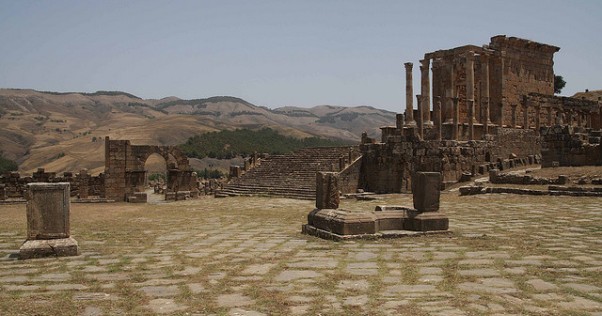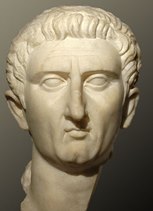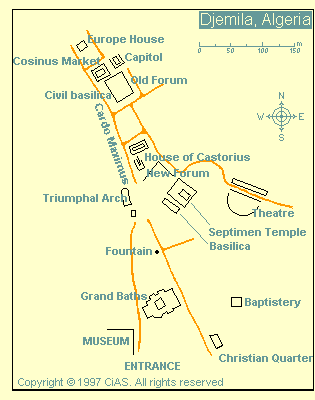

Location: Djémila
Map
Former name: Cuicul, Curculum
Inhabited: 1st- 6th century
Tel.
036 945 101
Entrance Fee: DA20, student DA10
Open: 9am- 12pm,
1:30- 5:30pm

Emperor Nerva (96 - 98 AD)

Djémila or Cuicul as it was known back then, was constructed by the Romans during reign of emperor Nerva (96 - 98 AD). The site was chosen at the confluence of the two rivers. Djemila is an extensive ancient Roman town that was added to a UNESCO World Heritage Site List. Unlike many Roman cities in Europe, Djemila was largely abandoned and hence it escaped a fate of vandalism by the local population. The city was inhabited by farmers and wheat traders that sold grains to all corners of the Roman Empire. In the ancient times Northern Algeria had much milder climate, that was perfect for growing crops without a threat of a sudden freeze. Residents of Djemila enjoyed their status as a major food supplier.
Two major streets, the Cardo Maximus and the Decumanus Maximus, created the two highways around which the city gradually grew. Initially the city was populated by the Roman army veterans who got their share of land. During reign of Caracalla New Forum was added to the city. In the 4th century AD Christianity spread through out the city. Its presence is marked by Baptistery as well as Christian Quarters situated in the South part of the ruins at the entrance. In the 5th- 6th century AD the site was abandoned probably due to invasion of Vandals from Europe during The Great Migration. The Arabs who conquered these lands did not rebuild the city, but they certainly marveled at the wonder of the ancient engineering giving ruins its today name of Djemila, which means "beautiful" in Arabic.
Logistics of getting there and back might be tricky. Make sure you start yearly in the morning then the sun is low and are the temperatures. Get a bus or a taxi driver. Personally I would suggest a bus. You can pinch in with other tourists to make it safer and more reliable trip. There are no hotels or motels in the village of Djemila itself. The closest you will get to civilization is probably Setif situated 50 km southwest of the site.
Djémila, formerly known as Cuicul, is a small mountain village and archaeological site located in Sétif Province, Algeria, near the northern coast east of Algiers, in the region bordering the Constantinois and Petite Kabylie. It sits at an elevation of approximately 900 meters (3,000 feet) above sea level on a narrow triangular plateau at the confluence of two rivers, providing a dramatic mountainous setting that influenced its Roman-era development. The site's coordinates are around 36°19′N 5°44′E, positioned about 40 kilometers northeast of Sétif and 60 kilometers from the Mediterranean coast. This rugged terrain, part of the Tell Atlas mountains, features hilly landscapes that required adaptations in urban planning, resulting in streets that follow the natural contours rather than a strict grid. The surrounding area supported ancient agriculture, including cereals, olive trees, and farms, contributing to the site's historical prosperity.
Djémila was founded between 96 and 98 AD under Roman Emperor Nerva as a military garrison in the province of Numidia, initially populated by Roman soldiers from Italy. Named Cuicul, it evolved from a strategic outpost into a thriving trading market and town during the 2nd century, benefiting from its agricultural resources. Expansion peaked in the early 3rd century under Emperor Caracalla, when the city outgrew its original ramparts, leading to the construction of a new forum and larger edifices. By late antiquity, it was part of the Roman province of Mauretania Sitifensis, with an estimated population of around 10,000 inhabitants. Christianity gained prominence in the 3rd and 4th centuries, with bishops from Cuicul attending key councils such as those in Carthage (255, 348, 411, 484) and the Second Council of Constantinople in 553. The city fell to the Vandals in 431 AD, saw a brief Byzantine revival in the early 6th century under Emperor Justinian I, who reinforced its walls, and was ultimately abandoned after the 7th-century Arab invasion. Muslims renamed the site Djémila, meaning "beautiful" in Arabic, but did not reoccupy it. Modern excavations began in 1909 and continued until 1957, uncovering its well-preserved remains.
Djémila exemplifies Roman urban planning adapted to a challenging mountain environment, with a layout centered around the forum and two main streets: the Cardo Maximus and Decumanus Maximus. Key structures include the Arch of Caracalla, a triumphal gateway built in the early 3rd century; the Septimius Severus Temple, dedicated to the imperial family; and a large theatre constructed outside the walls by Emperor Antoninus Pius, accommodating the rugged terrain. The site features two fora, including the Forum of the Harsh, a paved square with a majestic entry arch; a capitol; baths; a market; and temples such as the Temple of Venus Genitrix. Residential areas include fine houses with intricate mosaic paving stones depicting mythological scenes and daily life. The Christian quarter in the south comprises three basilicas, a cathedral, a baptistery, auxiliary rooms, a bath, a chapel, and a peristyle house, reflecting the site's religious evolution. These elements highlight Roman engineering, with adaptations like terraced construction and integration into the landscape for both functionality and aesthetic appeal.
Djémila stands as a testament to Roman cultural and architectural influence in North Africa, showcasing how urban planning was tailored to local geography while maintaining imperial standards. It represents the frontiers of the Roman Empire, serving as a military, economic, and later religious center that integrated local populations with Roman colonists. The site's mosaics and structures provide insights into daily life, mythology, and the transition to Christianity, with notable Romanized Africans originating from Cuicul. Today, it is a titular see of the Catholic Church, underscoring its enduring ecclesiastical legacy. Inscribed as a UNESCO World Heritage Site in 1982 under criteria iii (bearing unique testimony to a cultural tradition) and iv (outstanding example of a type of building or architectural ensemble), Djémila covers 0.3 square kilometers and is celebrated for its preservation and beauty.
Djémila attracts visitors for its exceptionally preserved ruins, offering opportunities to explore Roman history through guided tours of key sites like the theatre, arches, temples, and Christian quarter. The site's mosaics and panoramic mountain views enhance its appeal for photographers and history enthusiasts. It is accessible from Algiers in about 3 hours and 45 minutes via the A1 road, and hiring a guide is recommended for in-depth understanding. While specific opening hours and fees are not detailed, the site supports educational visits, with nearby accommodations in Sétif for extended stays. Activities include walking tours along ancient streets, viewing artifacts on-site, and appreciating the blend of Roman architecture with natural landscapes.
Conservation at Djémila involves ongoing archaeological work and restoration to maintain its structures against environmental wear and urban encroachment. The Zamani Project, in collaboration with the University of Setif and funded by the South African National Research Foundation, conducted spatial documentation in 2009, digitally preserving sites like the Baptistry, Caracalla Gate, Market, Septimius Severus Temple, and Theatre. As a UNESCO site, it benefits from international monitoring, though challenges include natural erosion from the mountainous climate and the need for continued excavations. Efforts focus on balancing tourism with preservation to prevent damage to fragile mosaics and ruins.
Standout features include the fine mosaics throughout the site, illustrating Roman artistry; the well-preserved bath complex; and the Christian buildings, such as the cathedral and baptistery, which highlight religious shifts. The Arch of Caracalla and the theatre offer iconic views, while the overall layout demonstrates innovative adaptation to the terrain. Although no major on-site museum is specified, the ruins themselves serve as an open-air exhibit, with some artifacts potentially housed in regional institutions. The site's "beautiful" moniker aptly captures its harmonious blend of history and scenery.